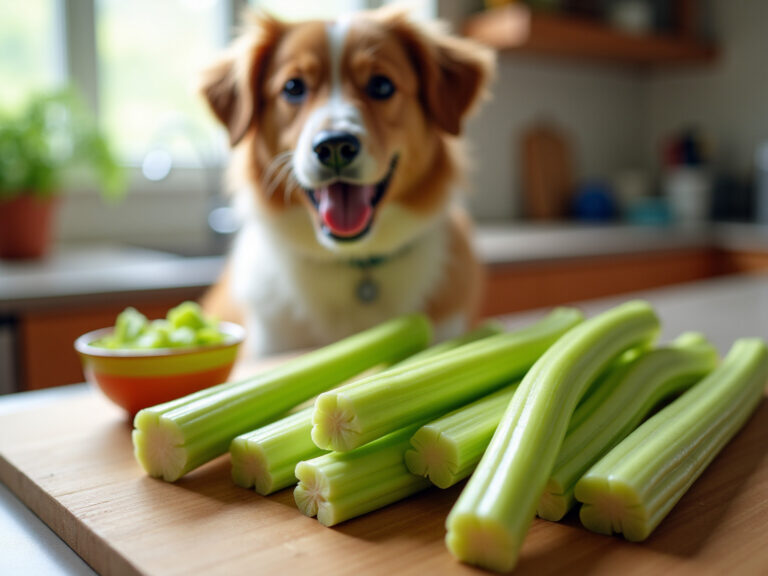Understanding Celery for Dogs: Benefits, Risks, and Preparation
Overview
As a loving pet owner, you want the best for your furry family members, and celery can be a wonderful addition to their diet. This crunchy treat is not only low in calories but also packed with essential vitamins A, C, and K, along with fiber that supports healthy digestion.
However, it’s important to prepare celery safely for your dog:
- Cut it into small pieces to prevent choking hazards.
- Introduce it gradually to avoid any digestive discomfort.
Remember, celery should make up no more than 10% of your dog’s daily caloric intake, ensuring a balanced and nurturing environment for your pet. By taking these simple steps, you can confidently offer your dog a healthy and enjoyable snack.
Introduction
Celery, often overlooked in the canine diet, is a hidden gem packed with nutritional benefits that can greatly enhance your furry family member’s health while serving as a delightful treat. This low-calorie vegetable not only satisfies your dog’s natural crunch craving but also provides essential vitamins and minerals that support their overall well-being.
However, as a caring pet owner, it’s important to be aware of the potential risks associated with feeding celery, such as choking hazards and digestive issues.
So, how can you safely incorporate this refreshing snack into your pet’s diet while maximizing its benefits? Let’s explore together!
Define Celery’s Role in a Dog’s Diet
Celery for dogs is a low-calorie vegetable that can serve as a nutritious treat for your furry family members, especially for those needing to manage their weight. While it may not be a staple in dog food, celery for dogs can be included as an occasional delight. With its high water content and crunchy texture, many dogs find celery for dogs appealing and enjoyable.
Nutritionally, celery offers several health benefits, including vitamins A, C, and K, along with potassium and fiber, all of which aid digestion and support overall health. Importantly, celery for dogs contains negligible amounts of fat and cholesterol, making it a healthy treat option for your beloved pets. To safely incorporate celery for dogs into your dog’s diet, wash it thoroughly, cut it into bite-sized pieces to prevent choking, and introduce it gradually to monitor for any digestive issues.
Be mindful that excessive intake of celery for dogs could lead to digestive discomfort, such as diarrhea or an upset stomach. Veterinarians frequently advise that snacks, including celery for dogs and other vegetables, should not exceed 10% of a dog’s daily caloric consumption. This ensures that while your dog enjoys the crunchy snack, their main nutrition remains balanced and healthy.
Consider innovative ways to serve celery for dogs by combining it with other dog-safe greens, like carrots or peas, or even preparing a frozen snack by spreading peanut butter in the stalks. Additionally, ensure that the celery is free from toxic ingredients like onions or garlic, and consider removing its leaves due to potential pesticide residues, unless using organic produce.
By learning how to safely incorporate celery for dogs into your dog’s diet, you can improve their nutrition while offering a flavorful and nutritious snack that they will love.
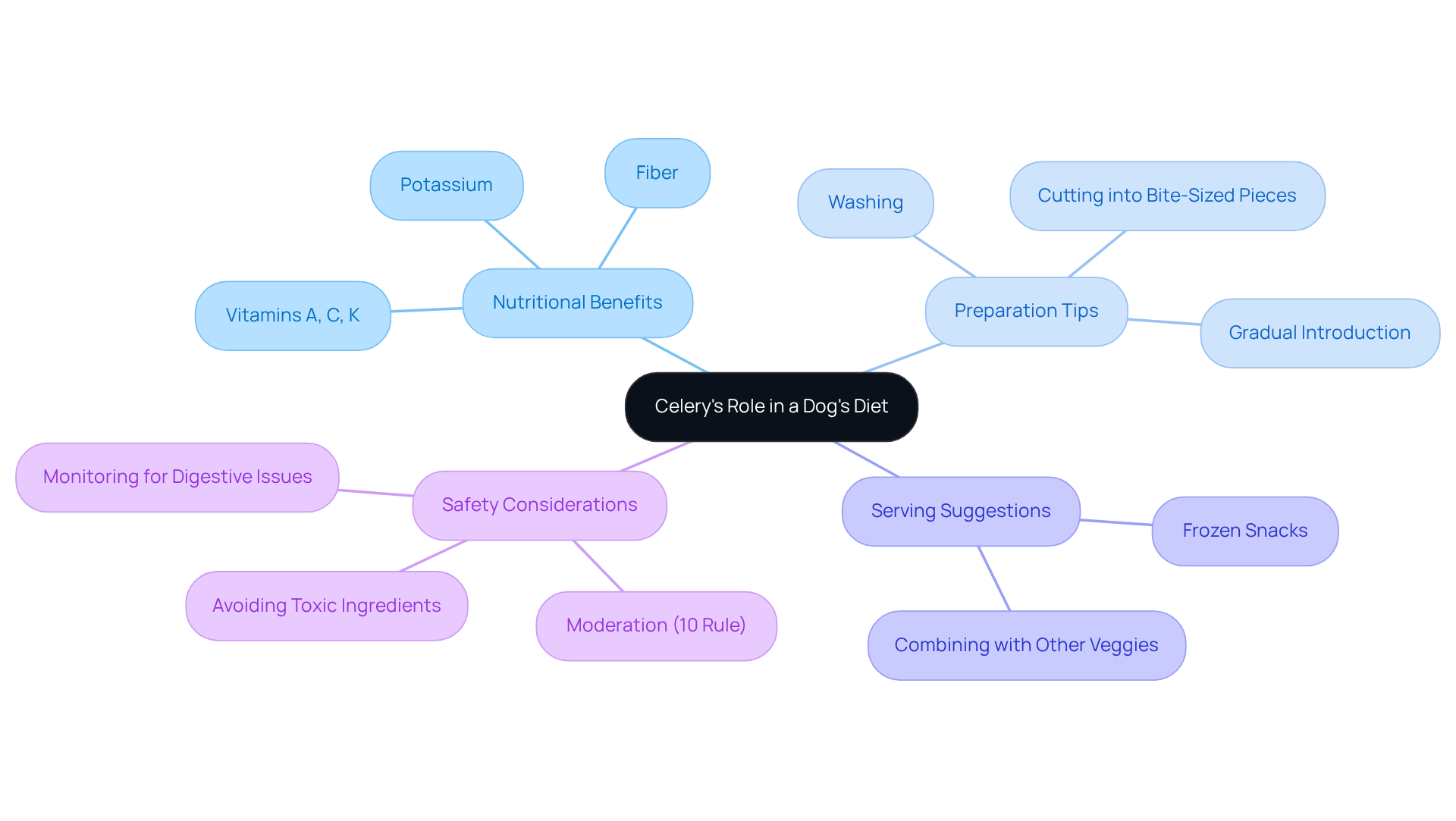
Explore Nutritional Benefits of Celery for Dogs
Celery for dogs is a powerhouse of essential nutrients that can greatly benefit your furry family members. Packed with vitamins A, C, and K, along with potassium and folate, this vegetable offers a wealth of advantages.
- Vitamin A is crucial for maintaining healthy vision and skin.
- Vitamin C acts as a potent antioxidant, bolstering the immune system.
- Vitamin K plays a vital role in blood clotting and supports bone health.
Moreover, incorporating celery for dogs, which has a high fiber content, promotes healthy digestion and helps regulate bowel movements, making it a wonderful addition to your dog’s diet for overall gastrointestinal health. With only 5-10 calories per stalk, celery for dogs serves as an ideal treat for those looking to shed excess weight or maintain a healthy weight. Its low-calorie nature, combined with its nutrient density, positions this vegetable as a valuable option, especially when introduced in moderation.
However, as a caring pet owner, it’s essential to be aware of potential risks.
- Choking hazards can arise if the vegetable is not cut into bite-sized pieces.
- Gastrointestinal upset may occur if fed in excess.
The high water content in celery for dogs makes it a refreshing snack, particularly during warm weather. Before adding any new food to your dog’s diet, it is advisable to consult a veterinarian to ensure it aligns with their specific health needs.
Remember, snacks like crunchy vegetables should constitute no more than 10% of your dog’s daily caloric consumption. An enjoyable way to present celery is by creating a pup-friendly version of ‘Ants on a Log’ using stalks, xylitol-free peanut butter, and dog treats. This not only provides a nutritious snack but also fosters a nurturing environment for your beloved pet.
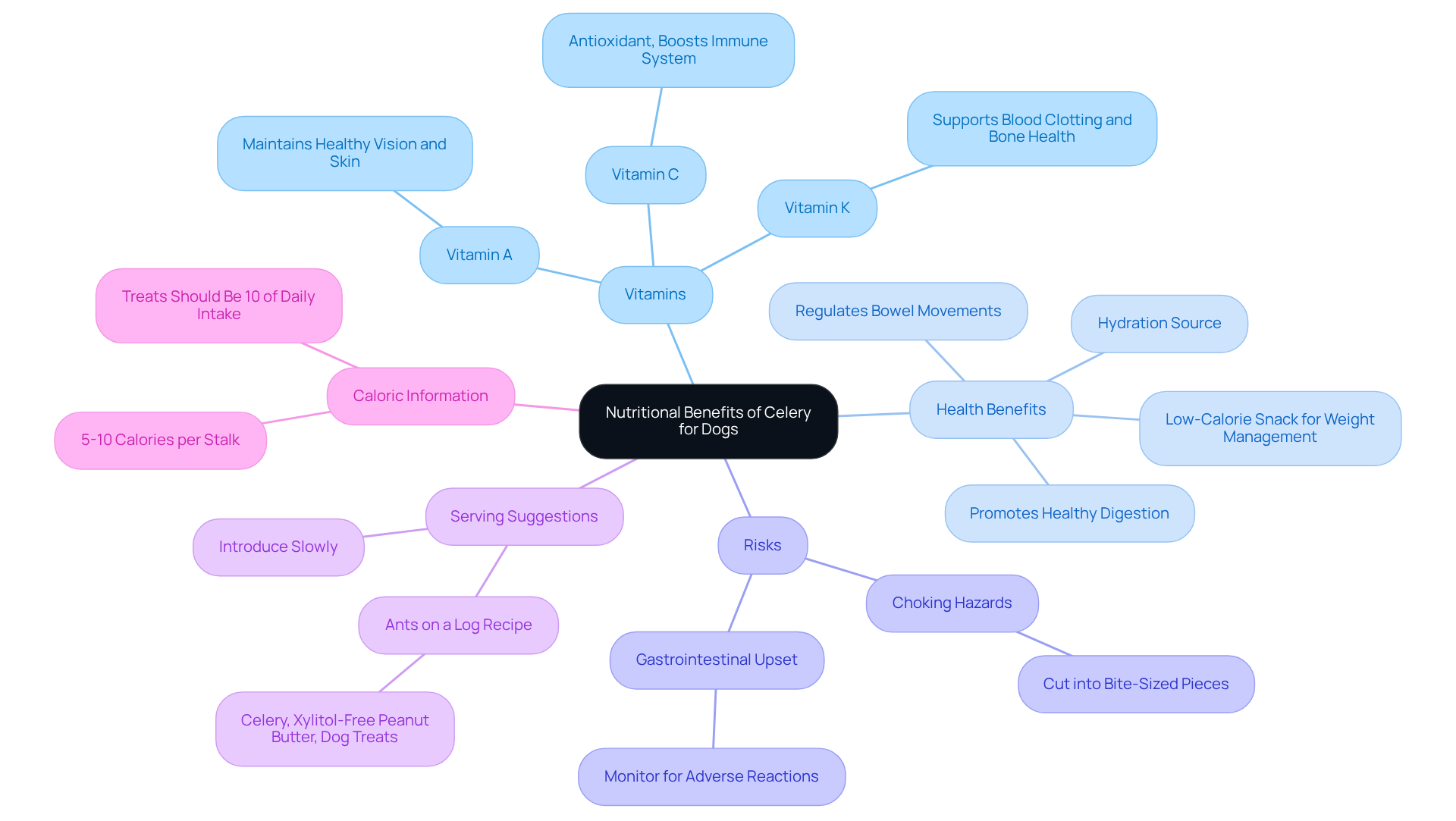
Identify Risks and Precautions When Feeding Celery to Dogs
While celery for dogs is generally considered safe for your furry family members, it does come with certain risks that pet owners should be aware of. The fibrous texture of this vegetable can create a choking hazard, particularly for small dog breeds such as Chihuahuas, Pomeranians, and Dachshunds. To mitigate this risk, it is essential to cut the vegetable into small, bite-sized pieces before offering it to your dog. Choking is a significant concern for pet owners, with many incidents occurring due to improperly prepared foods. In fact, choking hazards account for a notable percentage of emergency veterinary visits related to dietary issues in dogs.
Moreover, excessive consumption of this vegetable can lead to digestive issues, including diarrhea and gas. Celery for dogs is rich in vitamins A, C, and K, and its low-calorie content makes it a healthy treat option. However, it is crucial to recognize that too much of this vegetable can disrupt iodine metabolism, potentially raising the risk of hypothyroidism in canines. Though uncommon, some dogs might be allergic to this vegetable, making it essential to observe your pet for any negative responses when incorporating it into their meals. Veterinary advice emphasizes the importance of gradual introduction and careful observation to ensure a positive experience.
Dr. Alex Schechter, a veterinarian, advises that ‘celery for dogs can be a nutritious and enjoyable addition to your dog’s diet, provided it’s served in moderation and prepared safely.’ By taking these precautions, you can safely include celery for dogs as a nutritious treat for your furry friend. Remember, your pet’s health and happiness are paramount, and with thoughtful preparation, you can create a nurturing environment for them.
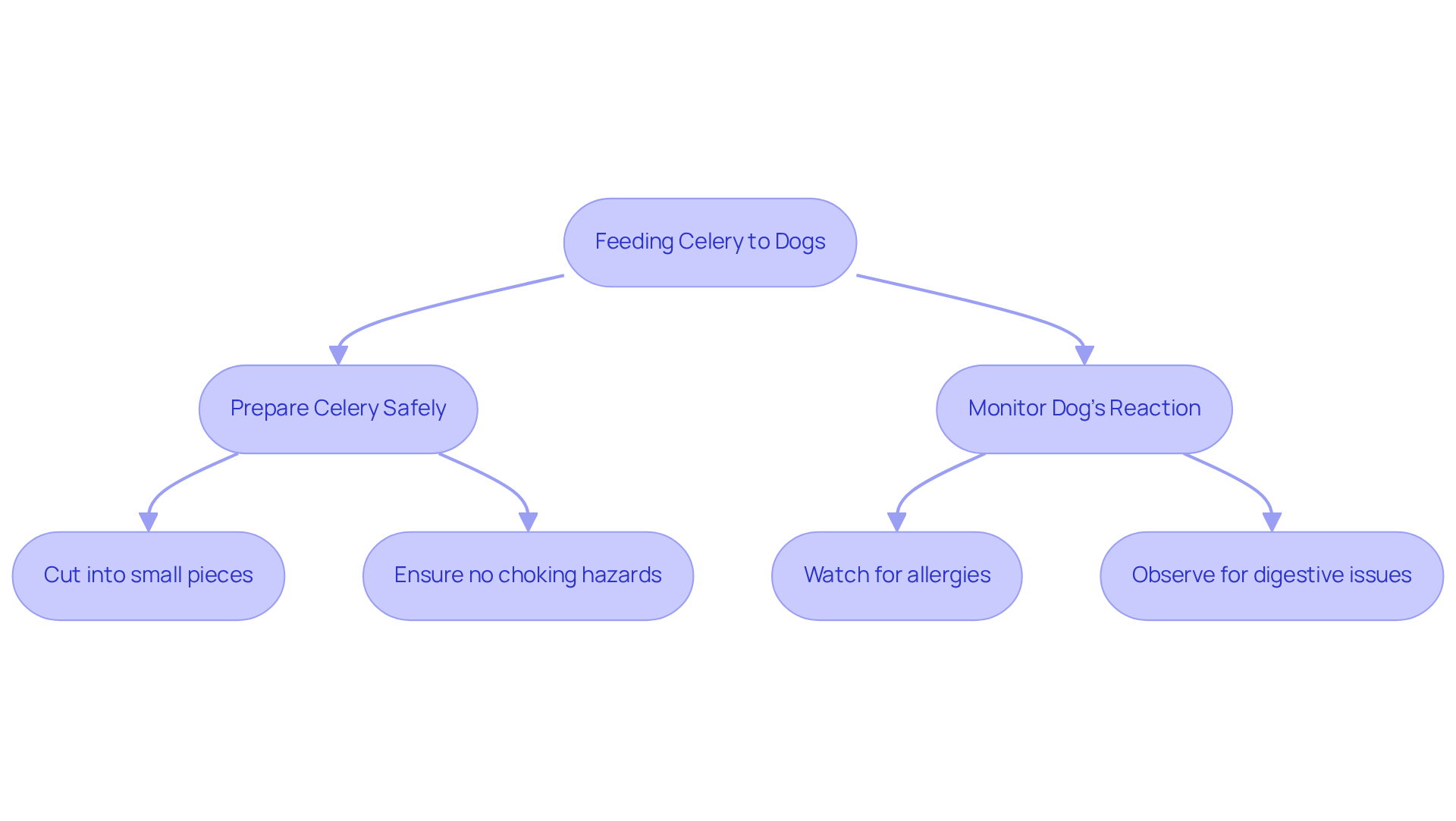
Prepare and Serve Celery Safely to Your Dog
To prepare celery for dogs, start by thoroughly washing the stalks to eliminate any dirt or pesticides. Opt for organic produce whenever possible to ensure the best for your pet. Next, cut the vegetable into small, bite-sized pieces to minimize choking hazards, especially for smaller breeds. While celery for dogs can be served raw or cooked, raw options are preferable as they retain more nutrients and are low in calories, making it a healthy treat.
Avoid adding dips or seasonings, as these can be harmful to dogs. Slowly incorporate celery for dogs into your dog’s meals, allowing time to observe for any negative responses, such as vomiting or diarrhea, ensuring a safe and pleasant experience. Remember, it’s also important to consult your veterinarian before introducing new foods to your dog’s diet.
For serving sizes, consider your dog’s size:
- Extra-small dogs: 1-2 pieces
- Small dogs: 2-3 pieces
- Medium dogs: 5-6 pieces
- Large dogs: a small handful
- Extra-large dogs: a handful
This thoughtful approach not only enriches your dog’s diet but also promotes their overall health, creating a nurturing environment for your beloved pet.
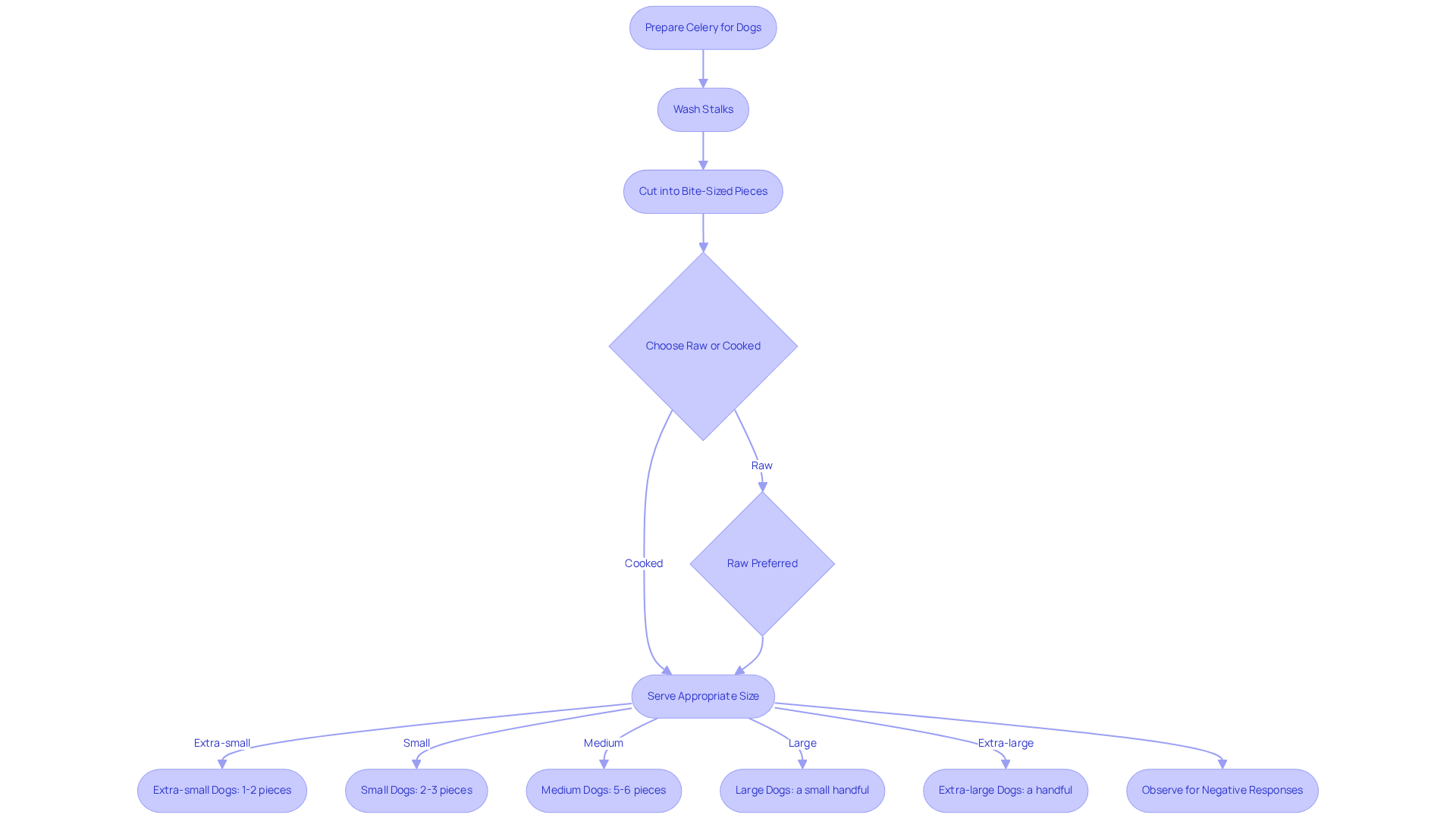
Conclusion
Incorporating celery into your dog’s diet can be a delightful way to enhance their nutrition while providing a low-calorie treat. This crunchy vegetable not only offers essential vitamins and minerals but also promotes healthy digestion and supports overall well-being. However, it is crucial to approach the introduction of celery with care, ensuring that it is prepared and served safely to avoid potential risks.
The benefits of celery for dogs are numerous. Its rich nutritional profile features vitamins A, C, and K, along with hydrating properties that keep your furry family members healthy. Yet, moderation is key; excessive consumption can lead to digestive issues or choking hazards. By following proper preparation guidelines—such as cutting celery into bite-sized pieces and monitoring your dog’s reaction—you can safely enjoy the advantages of this vegetable.
Ultimately, including celery in your dog’s diet serves as a reminder of the importance of balanced nutrition and thoughtful feeding practices. As pet owners, taking the time to understand the dietary needs of your dogs and exploring healthy treat options like celery can significantly contribute to their health and happiness. Embracing this knowledge not only fosters a nurturing environment for your pets but also empowers you to make informed decisions about your furry friends’ well-being.
Frequently Asked Questions
What is celery’s role in a dog’s diet?
Celery is a low-calorie vegetable that can serve as a nutritious treat for dogs, especially for those managing their weight. While not a staple in dog food, it can be included occasionally as a delightful snack.
What nutritional benefits does celery provide for dogs?
Celery offers several health benefits, including vitamins A, C, and K, potassium, and fiber, all of which aid digestion and support overall health. It also contains negligible amounts of fat and cholesterol.
How should celery be prepared for dogs?
To safely incorporate celery into a dog’s diet, wash it thoroughly, cut it into bite-sized pieces to prevent choking, and introduce it gradually to monitor for any digestive issues.
Can excessive celery consumption be harmful to dogs?
Yes, excessive intake of celery can lead to digestive discomfort, such as diarrhea or an upset stomach. It’s important to limit snacks, including celery, to no more than 10% of a dog’s daily caloric intake.
What are some creative ways to serve celery to dogs?
Celery can be served by combining it with other dog-safe greens like carrots or peas, or by preparing a frozen snack with peanut butter spread in the stalks.
Are there any precautions to take when giving celery to dogs?
Ensure the celery is free from toxic ingredients like onions or garlic, and consider removing the leaves due to potential pesticide residues unless using organic produce.





